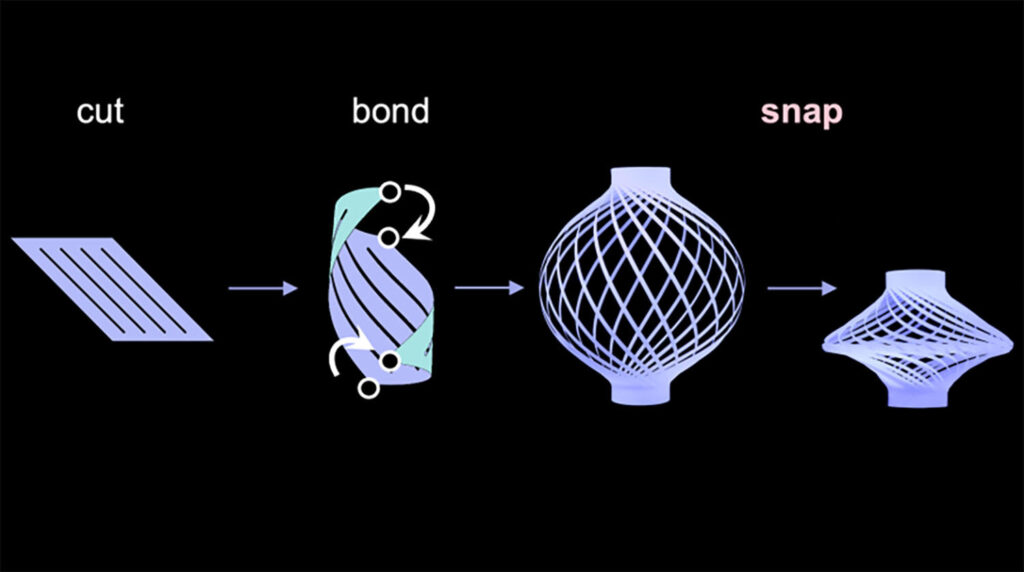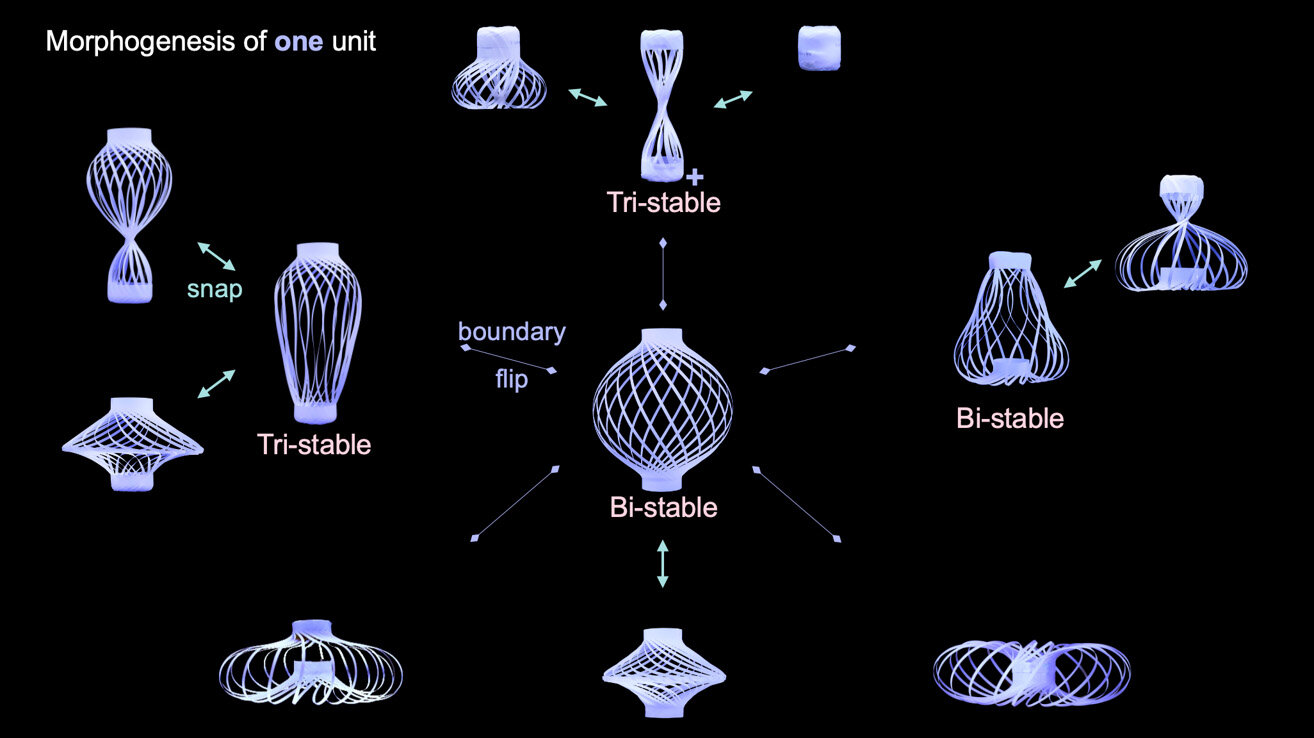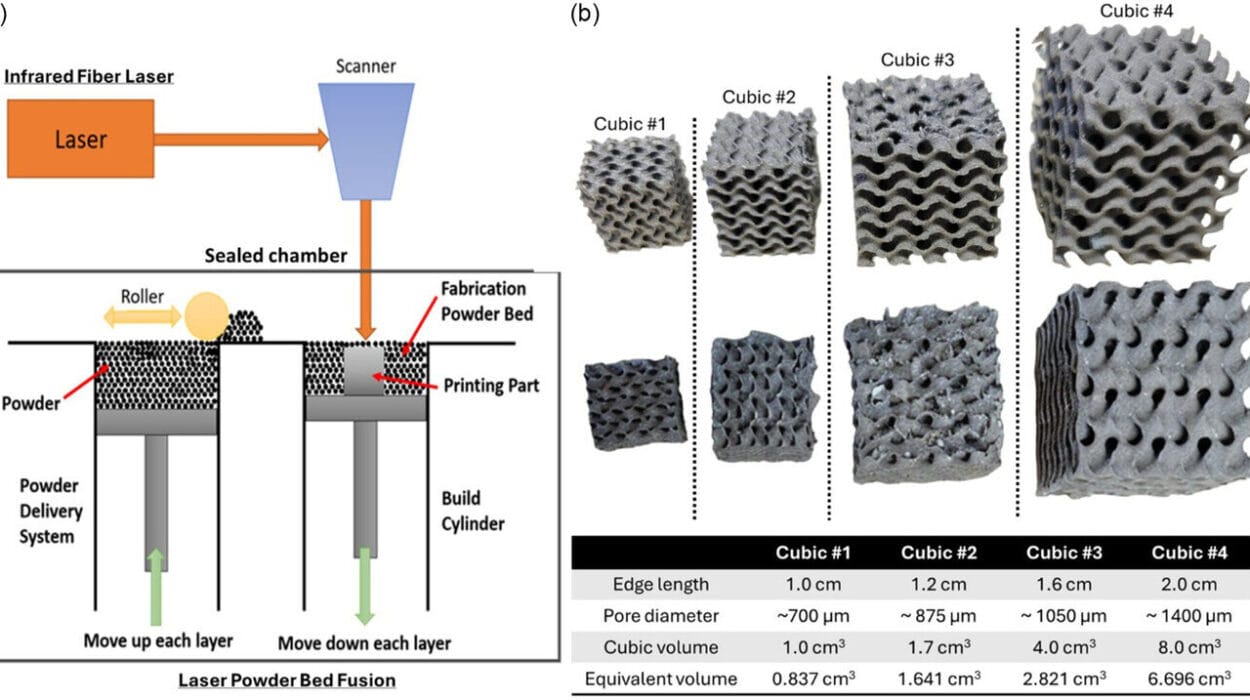Imagine a delicate paper lantern — the kind that glows softly during Chinese festivals, swaying gently in the evening breeze. Now imagine that same lantern is made not of paper, but of a smart polymer, and that it can twist, compress, and snap itself into more than a dozen different shapes — all on command. It can morph from a sphere into a spinning top, stretch upward like a blooming flower, or curl inward like a sea creature retreating into its shell. And most astonishingly, it can do all this not through motors or wires, but through the invisible pull of a magnetic field.
This is no work of science fiction. It’s a real scientific breakthrough from researchers at North Carolina State University, whose creation — a polymer “Chinese lantern” capable of reprogrammable shape-shifting — is redefining what’s possible in materials science and soft robotics. Their study, titled “Reprogrammable snapping morphogenesis in freestanding ribbon-cluster meta-units via stored elastic energy,” was recently published in Nature Materials.
The Birth of a Living Structure
At first glance, the polymer lantern seems simple. It begins as a thin, flat sheet of flexible polymer cut into a diamond-like shape. Across its center runs a series of parallel slits, forming a row of ribbons that remain connected by solid strips of material at the top and bottom. When the ends of these strips are joined together, the flat sheet curves gracefully into a spherical lantern shape — a form both familiar and elegant.

Yet within this delicate structure lies a world of complex physics. The lantern is not static. It possesses what scientists call bistability — the ability to rest naturally in two stable shapes. One is its relaxed, lantern-like form; the other is a compressed, spinning-top-like shape. When you push down on it, it slowly buckles, storing energy like a spring until it suddenly “snaps” into its second form. Release it, and that stored energy bursts free, snapping it back into its original lantern shape in an instant.
Professor Jie Yin, a mechanical and aerospace engineer at NC State and the study’s senior author, explains, “It has two stable forms. It’s stable as a lantern, and when you compress it, it reaches a point where it suddenly jumps into a second stable shape. Then, once you lift it again, all the stored energy releases at once, and it snaps back to the lantern.”
This snap-through motion — fast, powerful, and reversible — is the secret to its incredible potential.
When Matter Learns to Move
What makes this lantern more than just a clever mechanical toy is its adaptability. By slightly altering its geometry — twisting it, folding its top and bottom strips inward or outward, or combining these deformations — the researchers found they could create a wide variety of shapes. Some configurations were multistable, capable of snapping between not just two, but several stable states.
One design, for example, could hold four different forms depending on whether it was twisted, compressed, or both. Each transition between shapes stored and released elastic energy in a predictable way. In essence, the material became programmable — a structure that could remember multiple shapes and switch between them on demand.
This is what co-author Yaoye Hong, now a postdoctoral researcher at the University of Pennsylvania, describes as “reprogrammable morphogenesis” — the ability to control how a material transforms itself in three-dimensional space. “We found that each variation is also multistable,” Hong explains. “Some can snap back and forth between two stable states, while others can shift among four, depending on how you manipulate them.”
The Magic of Magnetism
But the real marvel comes from how these transformations can be controlled — remotely. By attaching a thin layer of magnetic film to the base of the structure, the team made it possible to twist or compress the lantern without touching it. A carefully tuned magnetic field can trigger the same snap-through transitions that pressure or force would cause manually.
With this capability, the lantern becomes more than an object — it becomes an actuator, a dynamic device that can perform work, move, and interact with its environment. The researchers demonstrated this potential through several striking examples:
They designed a noninvasive soft gripper that could gently grasp fish underwater without harm — a feat that rigid robotic claws could never achieve.
They built a smart filter that could open and close to regulate the flow of water.
They even created a rapid-expansion mechanism that could open a collapsed tube in an instant, hinting at applications in medicine and engineering.
Each demonstration revealed how this snapping mechanism could translate stored elastic energy into motion, offering precision and speed — yet powered only by the physics of the material itself.
Storing Energy in Shape
To truly harness this behavior, the team developed a sophisticated mathematical model. This model describes how changes in the lantern’s design — the angles, lengths, and curvatures of its ribbons and strips — affect both its shape and its ability to store and release energy.
In simple terms, the researchers can now predict and program how the lantern will behave. They can design it to hold more or less energy, to snap more forcefully or more gently, and to change shapes in specific ways. “This model allows us to program the shape we want to create, how stable it is, and how powerful it can be when stored potential energy is released,” says Hong. “All of those factors are critical for creating shapes that can perform desired applications.”
This capability marks a major step forward for the field of mechanical metamaterials — engineered materials whose properties are determined not by what they’re made of, but by their structure. By precisely controlling geometry, researchers can create materials that bend, twist, and move in ways nature never intended.
A New Chapter in Soft Robotics
The implications of this discovery ripple across disciplines. Traditional robotics relies on motors, joints, and electronic circuits to move and perform tasks. But soft robotics — a field inspired by the flexibility of living organisms — seeks to replace those rigid components with flexible materials that move through stored energy and structural intelligence.
The snapping polymer lantern is a perfect embodiment of this philosophy. It doesn’t need wiring or programming in the traditional sense. Its movements arise from geometry and physics alone. By arranging multiple lantern units together, the researchers envision entire surfaces or structures that can fold, roll, expand, or contract like living tissue.
“Moving forward, these lantern units can be assembled into 2D and 3D architectures for broad applications in shape-morphing mechanical metamaterials and robotics,” says Yin. “We’re exploring how to build systems that respond to magnetic, thermal, or light stimuli in complex and programmable ways.”
Imagine a soft robotic arm that can reshape itself to pick up delicate objects, a deployable structure that unfolds automatically in space, or medical devices that transform inside the body without invasive procedures. The polymer lantern is more than an experiment — it’s a glimpse into a future where machines are soft, adaptive, and alive with potential.
The Poetry of Elastic Intelligence
At its heart, this research captures something poetic: the ability of matter to remember, adapt, and move. What was once a flat, lifeless sheet becomes a dynamic structure capable of motion and transformation. Through clever design and mathematical insight, the researchers have unlocked a form of mechanical intelligence — a way for materials to store knowledge in their very shape.
It is a reminder that nature itself has long mastered such principles. Leaves curl, flowers bloom, and tendrils coil in response to environmental changes. The polymer lantern echoes these natural rhythms, bridging biology and engineering through elegance and simplicity.
In its quiet way, this creation tells a story about the future of science: one where technology learns from life, where machines mimic the grace of nature, and where even the simplest materials can come alive.
The polymer Chinese lantern doesn’t just shine — it breathes, it moves, and it teaches us that the boundary between living and engineered systems is growing thinner every day.
More information: Reprogrammable snapping morphogenesis in ribbon-cluster meta-units using stored elastic energy, Nature Materials (2025). DOI: 10.1038/s41563-025-02370-z.






